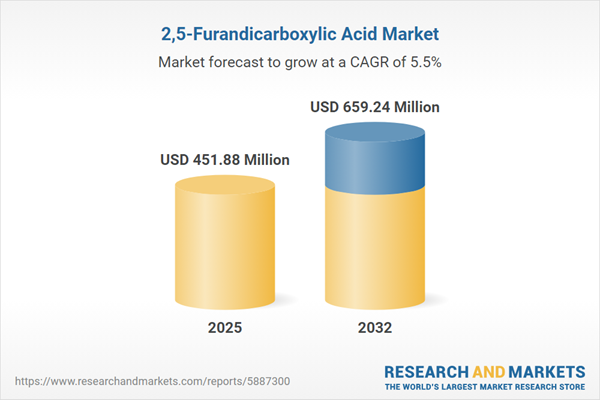Speak directly to the analyst to clarify any post sales queries you may have.
The 2,5-Furandicarboxylic Acid market is undergoing significant transformation, with senior leaders focusing on strategies that reinforce sustainability, drive digital innovation, and ensure transparent sourcing. These priorities are guiding the industry toward new standards in reliability, compliance, and market agility.
Market Snapshot: Size, Growth, and Trends in the 2,5-Furandicarboxylic Acid Market
The global 2,5-Furandicarboxylic Acid market is projected to expand from USD 429.83 million in 2024 to USD 451.88 million in 2025, with expectations to reach USD 659.24 million by 2032, reflecting a compound annual growth rate of 5.49%. This forward momentum is powered by a surge in bio-based technology investment, widespread adoption of digital solutions across the supply chain, and a dynamic shift in procurement practices. Companies are leveraging these drivers to unlock fresh value streams, boost operational responsiveness, and better align with evolving regulatory and customer requirements.
Scope & Segmentation: Strategic Overview for Senior Leaders
- Production Process: Examination of leading manufacturing approaches, including biomass conversion, catalytic oxidation, and innovations in electrochemical processes, with emphasis on efficiency, environmental impact, and adaptability to regulatory change.
- Purity Levels: Assessment of grades below and above 98% purity, enabling organizations to meet the exacting specifications of sectors such as pharmaceuticals, electronics, and advanced materials.
- Application Sectors: Analysis of diverse end uses encompassing adhesives, specialty coatings, pharmaceutical intermediates, sustainable packaging, sealants, and bio-based polymers, providing alternatives for firms committed to reducing reliance on petrochemicals.
- Sales Channels: Review of conventional and digital sales strategies, promoting increased procurement transparency and agile response to shifting client needs through technology-enabled platforms.
- Regional Coverage: Insight into key regions, including the Americas, Europe, Asia-Pacific, Middle East, and Africa, with particular attention to local regulatory developments, logistics frameworks, and supply chain complexity that inform competitive market entry.
- Companies Profiled: In-depth coverage of industry leaders such as AstaTech Inc., AVA Biochem AG, Avantium N.V., BASF SE, Biosynth Ltd, Carbone Scientific CO., LTD, Chemsky (Shanghai) International Co., Ltd., Corbion NV, Eastman Chemical Company, Merck KGaA, MOLBASE, Novamont S.p.A. by Versalis, Sarchem Laboratories Inc., Spectrum Laboratory Products, Inc., Thermo Fisher Scientific Inc., Tokyo Chemical Industry Co., Ltd, and VIVAN Life Sciences Pvt. Limited.
Key Takeaways: Strategic Insights for Senior Decision-Makers
- Leveraging 2,5-Furandicarboxylic Acid facilitates sustained progress on sustainability objectives and supports compliance as global standards grow more stringent, encouraging adaptive and forward-thinking operational approaches.
- Deploying advanced production technologies such as catalytic oxidation and electrochemical innovation fosters improvements in efficiency and supports resilience in shifting economic and industry landscapes.
- Maintaining stringent purity and quality protocols broadens market access, particularly for applications in regulated environments including high-growth electronics and medical sectors.
- Optimizing procurement with digital systems and expanding distribution capacity accelerates decision-making, enabling timely and efficient response to market fluctuations and demand changes.
- Cross-functional collaboration in manufacturing, research, and logistics underpins supply chain reliability, streamlines risk mitigation, and enables faster adaptation to shifts in regulations or customer expectations.
- Tailoring go-to-market strategies to specific regulatory and infrastructure profiles supports project execution success, strengthening competitive positioning across complex global markets.
Tariff Impact and Strategic Adjustments
Recent adjustments in North American tariffs are prompting companies active in the 2,5-Furandicarboxylic Acid sector to adopt new sourcing models. Organizations are enhancing domestic production, adopting flexible inventory practices, and increasing engagement in trade forums. These measures help reduce exposure to policy-related volatility, stabilize supply, and sustain compliance in uncertain regulatory conditions.
Methodology & Data Sources
This market analysis is built on insights from expert interviews and ongoing industry tracking, complemented by thorough reviews of scientific literature and patents as well as evaluation of global regulatory frameworks. This comprehensive approach provides reliable, actionable data for senior decision-makers.
Why This Report Matters: Actionable Intelligence for Senior Leaders
- Empowers organizations to optimize supply chain processes and vendor selection, supporting efficient and consistent value creation through all stages of the value chain.
- Enables executives to anticipate regulatory changes and rising sustainability demands, ensuring timely compliance and lower risk across developing and established markets.
- Strengthens leadership strategies for managing operational risk, maintaining business continuity, and enabling rapid adaptation amid evolving industry and policy environments.
Conclusion
This report delivers essential insights for senior leadership, offering clear direction to achieve sustainability goals, adapt critical market strategies, and remain competitive within a fast-changing renewable chemicals landscape.
Additional Product Information:
- Purchase of this report includes 1 year online access with quarterly updates.
- This report can be updated on request. Please contact our Customer Experience team using the Ask a Question widget on our website.
Table of Contents
3. Executive Summary
4. Market Overview
7. Cumulative Impact of Artificial Intelligence 2025
Companies Mentioned
The companies profiled in this 2,5-Furandicarboxylic Acid market report include:- AstaTech Inc.
- AVA Biochem AG
- Avantium N.V.
- BASF SE
- Biosynth Ltd
- Carbone Scientific CO.,LTD
- Chemsky (shanghai) International Co., Ltd.
- Corbion NV
- Eastman Chemical Company
- Merck KGaA
- MOLBASE
- Novamont S.p.A. by Versalis
- Sarchem Laboratories Inc.
- Spectrum Laboratory Products, Inc.
- Thermo Fisher Scientific Inc.
- Tokyo Chemical Industry Co., Ltd
- VIVAN Life Sciences Pvt. Limited
Table Information
| Report Attribute | Details |
|---|---|
| No. of Pages | 191 |
| Published | November 2025 |
| Forecast Period | 2025 - 2032 |
| Estimated Market Value ( USD | $ 451.88 Million |
| Forecasted Market Value ( USD | $ 659.24 Million |
| Compound Annual Growth Rate | 5.4% |
| Regions Covered | Global |
| No. of Companies Mentioned | 18 |









